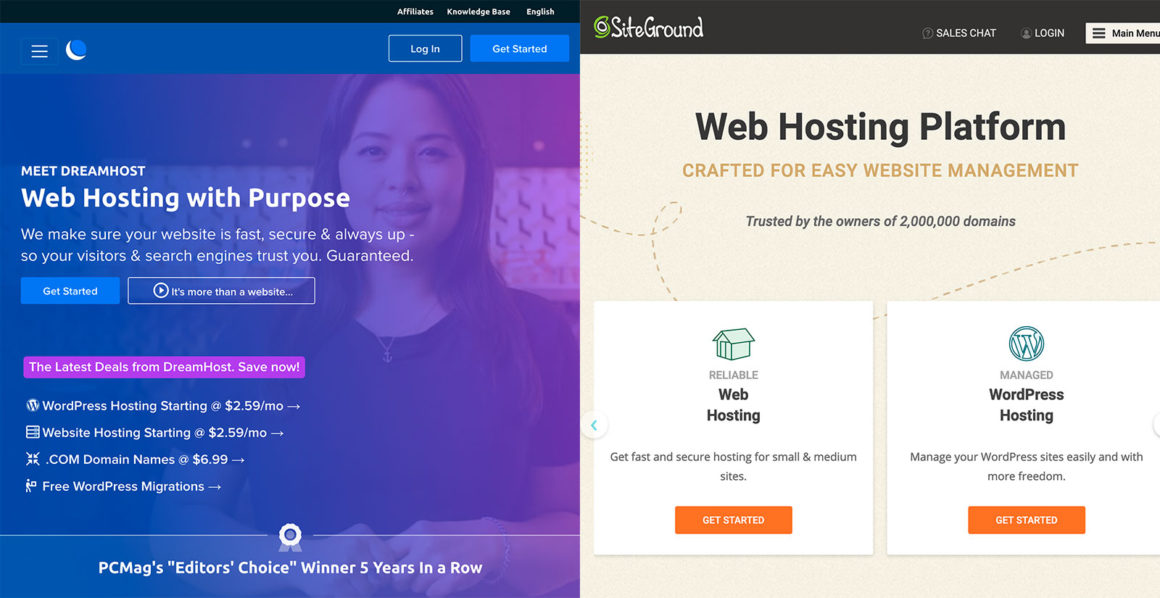- By Joe Fylan
- January 10, 2021
If you’re looking for a new home for your existing website, or you’re planning to start a new site, DreamHost and SiteGround are two hosts that deserve a place on your shortlist, especially if you’re looking for a great value yet high performance shared hosting plan.
However, while the shared hosting plans DreamHost and SiteGround have quite a few things in common, they also have some notable differences, not least their prices.
So to help you decide which shared hosting plan is best for you, we’ve explored the main features of both hosts, used paid tools to measure the performance of their shared hosting plans, and dug into the technical details to give you a clear picture of exactly what you’ll get with each company.
If it’s time to start a new website or change the host of your existing site, by the end of this comparison, you’ll know whether SiteGround or DreamHost is the best option to sign up with, or if your search continues.
Let’s begin…
About DreamHost and SiteGround
DreamHost have been in business since 1996, making them one of the most well-established web hosts in operation today. They offer a wide range of hosting plans, including their DreamPress managed WordPress hosting service, dedicated server hosting, and the low-cost shared service we’re looking at in this comparison.
Although SiteGround have “only” been around since 2004, they have built up a great reputation, especially among WordPress users, thanks to their fast servers, professional support, and useful features. This all makes SiteGround a safe choice for anyone looking for high-quality shared hosting.
However, the SiteGround plans are quite expensive compared to some other well-known shared hosting providers. DreamHost, on the other hand, have some of the cheapest plans around.
So is it worth paying extra for SiteGround hosting, and do the low-price DreamHost shared plans cut too many corners? By the time you’ve finished this DreamHost vs SiteGround comparison, you’ll know which one is the best option for your website.
DreamHost and SiteGround Shared Hosting Plan Details
Before we explore the main features of DreamHost and SiteGround and see the results from our speed and load handling tests, here’s a quick overview of their shared hosting plans.
DreamHost Shared Hosting Plans

DreamHost keep things simple with just two shared hosting plans for you to choose from:
- Shared Starter: From $2.95 a month for one website and 50 GB of storage.
- Shared Unlimited: From $4.95 a month for unlimited websites and unlimited storage.
As you can see, the main differences between the two plans are the number of websites you can host and the amount of storage you get access to. There are a few other differences, such as the number of subdomains and MySQL databases you can create. Both plans have unlimited bandwidth so that your website(s) can receive as many visitors as you can attract, provided you follow the usage guidelines.
Unlike the SiteGround shared plans, there are no differences in performance between the DreamHost plans. Due to this, your website should load at the same speed, regardless of which plan you choose.
When it comes to money-back guarantees, DreamHost will give you a full refund if you cancel your plan within 97 days of opening your account.
You can see the full comparison of the two plans on the DreamHost shared hosting page.
SiteGround Shared Hosting Plans

SiteGround have hosting for all types of websites including three shared hosting plans.
SiteGround have three different shared hosting plans for you to choose from:
- StartUp: From $6.99 for one website, 10 GB of storage, and ~ 10,000 visits monthly.
- GrowBig: From $9.99 a month for unlimited websites, 20 GB of storage, and ~ 25,000 visits monthly.
- GoGeek: From $14.99 a month for unlimited websites, 40 GB of storage, and ~ 100,000 visits monthly.
Like the DreamHost plans, the SiteGround plans support unlimited traffic. The monthly visits number is there to give you an idea of what size of audience each plan was designed to handle.
As well as the storage and recommended monthly visits, there are a few other differences between the SiteGround plans that we’ll cover in this review. One that’s worth mentioning now, though, is that the higher-priced plans include extra performance features that should help make your website faster.
While DreamHost have a 97-day money-back guarantee, SiteGround give you 30 days after signing up to cancel your plan and get a full refund.
You can compare the details of the plans on the SiteGround website.
Hosting Discount Rates
The prices listed above for DreamHost and SiteGround are the lowest equivalent monthly fees you’ll pay. These lower rates can be accessed by paying for more than a month up front, with the longer your initial payment period, the more you’ll save.
As both hosts offer three-year contacts (as well as shorter ones), you can lock in the lower rates for a significant amount of time. Once the period covered by your first invoice is up, you’ll then pay the full price for your plan going forward.
As the SiteGround plans are discounted by over 50% for new customers, your monthly hosting fees could increase significantly when it’s time to renew your plan. With DreamHost, the difference between the new customer rates and the full price isn’t as big, but nonetheless, the full price is something to consider when choosing a plan.
Shared Hosting Feature Comparison
With pricing out of the way, let’s explore the main features of the SiteGround and DreamHost shared plans and see how they differ between hosts.
Domains and SSL Certificates
All websites need a domain name, and these days, an SSL certificate is pretty much essential, too, if you want your website to be able to keep your users’ data secure.
So with that in mind, it’s great to see that both hosts provide you with free SSL certificates from Let’s Encrypt.
What’s even better is that, with all of the SiteGround shared plans and the more expensive DreamHost Shared Ultimate plan, SSL certificates are applied to your sites automatically. With the lower-priced Shared Standard plan from DreamHost, you have to apply it yourself; however, DreamHost make this a very straightforward process.
If you’d rather not use the free Let’s Encrypt SSL certificates, both hosts make it easy to use paid certificates on your site, with some options available for purchase directly from DreamHost and SiteGround.
While most hosts now offer free SSL certificates that are often automatically applied to your website, as we saw in our recent GoDaddy vs Bluehost comparison, this isn’t always the case.
When it comes to a domain name for your website, signing up for either of the DreamHost shared plans on a 12-month or longer contract includes one year’s free domain registration.
SiteGround don’t offer free domain names, but they do have a domain registration service. You can also register one elsewhere and point it to your hosting account.
The price of registering a domain name for your website varies depending on which extension you’d like (e.g. .com, .net, etc.) and where you choose to register it; however, you could end up saving around $10 by taking advantage of this offer from DreamHost. However, be sure to check the DreamHost domain renewal rates and other conditions before deciding whether to claim your free domain from them or register one elsewhere, as doing so might be a better option.
Verdict: While both hosts have great SSL support, DreamHost win here as you get a free domain name registration if you sign up for 12 months or longer.
Website and Account Backups
If you don’t want to run the risk of losing your website and account data, it’s vital that you implement some sort of backup system.
Thankfully, both DreamHost and SiteGround will back up your account, including your files, database, and email accounts, automatically, every day. Then, if something goes wrong, you’ll always have a backup you can restore that’s less than 24 hours old.
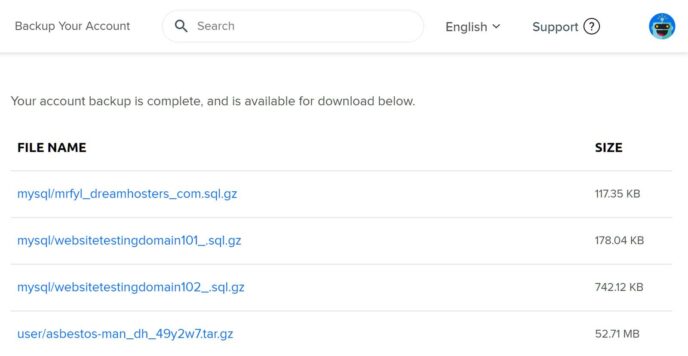
DreamHost backups include your files. database, and emails.
As well as the daily automated backups, you can also manually create a limited number of backups on-demand on the top two SiteGround shared hosting plans (GrowBig and GoGeek) and on all of the DreamHost plans.
While both hosts do provide backups, the SiteGround system is superior to the DreamHost one. As you can see on the SiteGround backup tool support page, their system lets you restore the entire backup, or just parts of it, such as all or some of the files, database, and emails, all through an intuitive user interface.
With DreamHost, you can restore all the files from your backup and your database backup in just a few clicks through your account area. However, while you can choose which database table to restore, you can’t restore individual files and can only perform a full restore of an entire backup file.
WordPress Website Backup Options
While these backup features do ensure your account and (WordPress) website is backed up, if you’re using WordPress for your website, you might want to consider a solution built for this type of site.
Doing so should give you more control over when and how your backups are created and increase your options for restoring your website files and database.
However, while you can install a WordPress backup plugin, DreamHost customers won’t need to. This is because the DreamHost shared plans come with a premium subscription to BoldGrid WordPress Website Builder package (worth $5 a month) that includes access to a selection of themes, the BoldGrid page builder tool, and their Total Upkeep backup plugin.
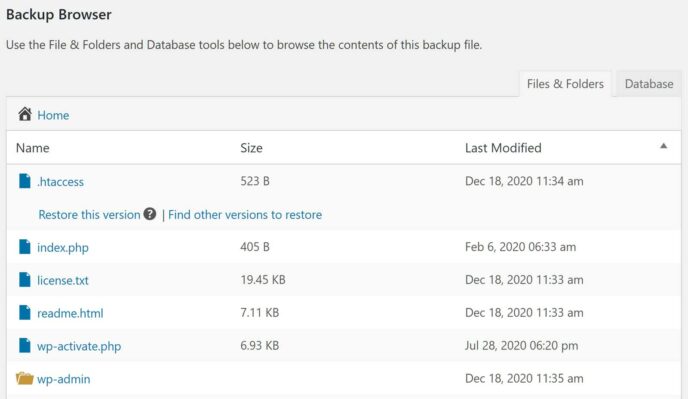
Total Upkeep Premium, which comes with the DreamHost plans, lets you restore individual files from your website backups.
With the premium version of the Total Upkeep plugin running on your WordPress website, you can create an automatic backup schedule as well as back up your site on demand, see a history of changes to your WordPress website, and view recently modified files. Restoring complete or partial backups is very straightforward, too.
You can also have your backups automatically uploaded to cloud services, such as Google Drive, Amazon S3, and the DreamHost DreamObjects file storage service. Total Upkeep can be set to automatically back up your site before the WordPress software, plugins, and themes are updated, with the option of enabling the automatic restoration of that backup if a problem with the update is detected.
Unfortunately, the SiteGround shared plans don’t include access to a WordPress-specific backup tool, let alone a powerful one similar to Total Upkeep. However, you can easily add your own choice of free or paid WordPress backup plugin to your site, including Total Upkeep.
When it comes to choosing a WordPress backup tool, there are many options available, depending on your budget. Some popular options include the freemium UpdraftPlus plugin and the very impressive but relatively expensive Jetpack Backup solution.
Verdict: Although SiteGround has a better whole-account backup system than DreamHost, the premium WordPress backup plugin that comes with the DreamHost shared plans is a tool that all website owners will appreciate, making DreamHost the winner here.
Caching and Optimization
Both hosts claim to make high-performance servers and technology available to their customers to ensure fast site speed and good levels of uptime. You can decide if you agree with this or not after you’ve seen the results from performance tests.
SiteGround definitely have more readily available information on their website about their hosting infrastructure and why you should choose them over their rivals.
For example, one area where SiteGround differs from DreamHost is that they now use the Google Cloud platform as the base for their hosting infrastructure. What this means is that you can host your site on the state-of-the-art Google Cloud network, in a hosting environment managed by SiteGround, for just a few dollars a month.
By using the Google Cloud platform, SiteGround now have access to a high-end infrastructure, with options for hosting their customers’ websites in more locations around the world. If you want your website to be as physically close to your visitors as possible in order to keep loading times down, there’s a good chance you can achieve this with SiteGround. With DreamHost, there are just two centers available, both in the US.
Furthermore, SiteGround also have a feature-rich WordPress plugin that provides you with lots of ways to optimize your website.

SiteGround have a plugin that adds many performance optimization features to WordPress websites.
The features of the free SG Optimizer plugin enable you to easily optimize new and existing images, combine and minify HTML, CSS, and JavaScript files, and enable lazy loading, plus a lot more, all from inside your WordPress dashboard.
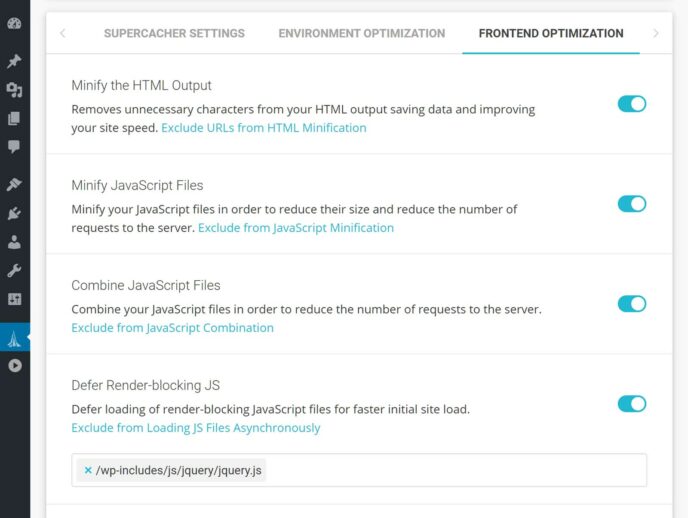
SiteGround users can optimize their site via the SG Optimizer plugin.
You can also effortlessly convert your images to the new WebP format, reducing their file size without affecting their quality.
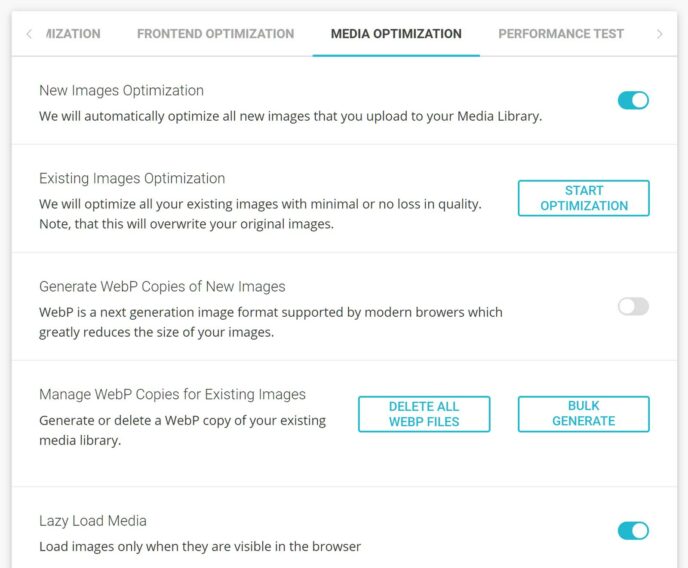
SiteGround makes it easy to use the WebP compression format to create smaller image file sizes.
While DreamHost doesn’t have its own caching and optimization plugins or tools, the popular and free WP Super Cache plugin is added to any WordPress installations you create through your account dashboard. You can also install your own choice of WordPress caching and optimization plugin instead.
Regarding other server technologies, both hosts use OPcache to enhance the performance of websites that use PHP, such as WordPress. SiteGround also makes Memcached available on all of its shared plans, apart from the entry-level StartUp plan.
As Memcached helps to improve the performance of sites that use database queries, including WordPress websites, it’s a feature that’s worth having. With DreamHost, Memcached is only available on their non-shared hosting plans. You can quickly see what technologies DreamHost use on this helpful page on their website. SiteGround have a similar page that you can view here.
To enable you to distribute your content around the world, DreamHost and SiteGround both support the Cloudflare CDN service and make it easy to use this service on your website. Other CDNs are supported, too.
Verdict: SiteGround win here as they make more technology available to their shared hosting customers and have a useful plugin for optimizing WordPress websites.
WordPress Features
While both DreamHost and SiteGround have specific hosting plans for WordPress websites, their shared plans fully support WordPress and have some useful extra features for this type of site that we’ll explore now.
Automatic WordPress Installation
With both hosts, you can choose to have WordPress installed automatically during sign up. Installing WordPress yourself at any other time is very straightforward, too, thanks to the software installer tools.
WordPress Starter Wizards
To help you build your new WordPress website, both hosts also have optional wizards that are displayed in your WordPress dashboard.
With SiteGround, you get access to their WordPress Starter wizard, which will help you choose a theme, recommend some useful plugins, and simplify the process of creating content for your new site.

You can choose from a selection of WordPress themes from BoldGrid when setting up your site with DreamHost.
As mentioned earlier, DreamHost have teamed up with BoldGrid to give you the option of adding some extra tools to your WordPress website. Through this integration and the setup and website builder wizard, you can choose a theme from BoldGrid from inside your WordPress dashboard and carry out some of the other tasks involved in setting up your site. You can also use the paid BoldGrid Website Builder for free to customize the design of your site.
If you’re new to WordPress, then these startup wizards should help you build your website and get it ready for launch.
Automatic WordPress Updates
To save you a job, both hosts can automatically update the WordPress software and any plugins you’ve installed, with DreamHost also offering automatic theme updates via the Total Upkeep plugin.
Although WordPress 5.5 includes automatic updates of the core software, plugins, and themes, SiteGround and DreamHost have a few extra auto-update features you might find useful.
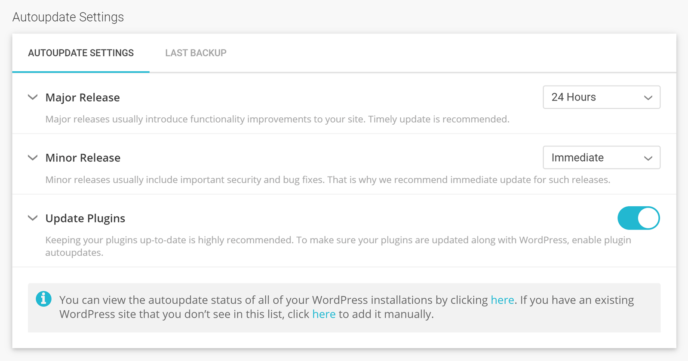
Both SiteGround (pictured) and DreamHost support automatic WordPress website updates.
If you use Total Upkeep, which is included with the DreamHost shared plans (and available separately), to manage your automatic updates, the plugin will create a backup of your site before performing any updates. SiteGround will also automatically back up your site before an update is installed. You can delay the installation of updates with both hosts as well, but with SiteGround, you can’t prevent them from being installed.
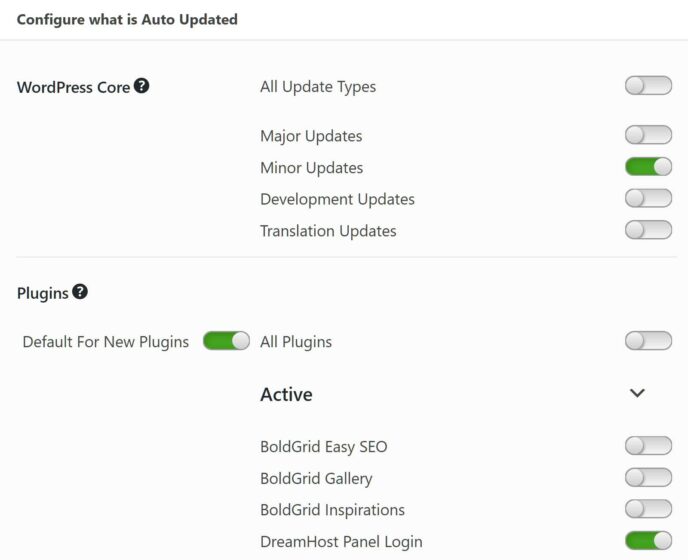
Both hosts will help keep your website up to date but DreamHost and the Total Upkeep plugin (pictured) give you more control over how this works.
If Total Upkeep detects an error during the update, it will automatically restore the backup file.
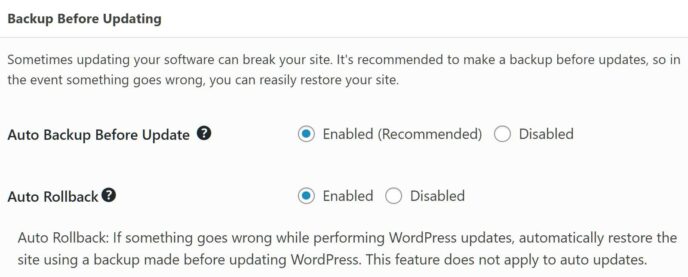
Total Upkeep, which comes with DreamHost plans, can automatically restore a backup if an update goes wrong.
WordPress Caching and Optimization Tools
The previously mentioned SiteGround caching and optimization plugin also includes features to help you manage your website and optimize its content for faster loading times.
With DreamHost, WordPress installations include the free third-party WP Super Cache plugin, or you can install another plugin from this category.
Both hosts also have lots of documentation on their websites to support your WordPress use.
WordPress Staging
A staging tool lets you quickly create a copy of your website for testing and development purposes, and SiteGround include this feature for WordPress websites on their top two shared hosting plans (GrowBig and GoGeek).
DreamHost don’t include a staging tool on their shared plans and recommend you create the site manually.
Verdict: It’s a draw as the DreamHost shared plans include some premium tools for free via BoldGrid, while the SiteGround plans include a powerful staging tool and optimization features for WordPress users. Your needs will dictate which set of features is more useful.
User Support
You can contact both hosts via live chat 24/7. However, while DreamHost let you request a call back from their support team, you can phone the SiteGround help desk directly. SiteGround also offer email support, and contact made by customers on their top GoGeek plan are given priority.
While it was easy to connect to both hosts via live chat, during testing, I’ve found the SiteGround support staff to be the most responsive and helpful of the hosts I’ve used.
Verdict: More options for contacting support and their helpful staff make SiteGround the winner.
DreamHost vs SiteGround Performance Tests
As you can see, both hosts have some great features, including free SSL certificates, website backups, and automatic software updates on their affordable shared hosting plans.
However, as well as features and cost, it’s also very important to take performance into consideration.
After all, the best features and lowest prices won’t mean much if your website is slow, unable to handle more than a few visitors accessing it at the same time, and suffers from frequent downtime.
So with that in mind, let’s find out whether the DreamHost or SiteGround shared plans have the best performance.
About the Tests
For the tests, I first used Pingdom to monitor the speed of our sites to find their average load time. After that, I used K6 (formerly Load Impact) to see how the sites performed when multiple simultaneous visitors were accessing them. You’ll also find the results from my uptime monitoring, again using Pingdom. For each test, the testing location nearest to where the site was hosted was chosen.
Load Time Testing
To find out which host is the fastest, I created two WordPress websites on the DreamHost Shared Ultimate plan and two on the entry-level SiteGround StartUp shared plan.
It’s worth mentioning again that while both of the DreamHost shared plans provide the same levels of performance, the StartUp plan has the lowest performance (and lowest price) of the three shared plans from SiteGround.
If you want to know more about the differences between the SiteGround shared plans, including the differences in performance, you can check out our StartUp vs GoGeek SiteGround comparison.

Unlike DreamHost, the SiteGround shared hosting plans have different levels of performance.
For each host, I installed a lightweight theme on one of the test sites, and on the other, a heavyweight theme, and then imported one of that theme’s demos. The speed of a page from the sites was monitored by Pingdom.
Here are the results…
Lightweight Theme Speed Test Results
If you plan to create a simple website or blog, using a free lightweight theme like Twenty Twenty is a great option.
Thanks to its modest feature list and clean code, you shouldn’t have to worry about the design of your site negatively impacting your load times when using Twenty Twenty.

Twenty Twenty is a popular free theme from the WordPress team.
To give you an idea of how fast your website might load if you host it with either SiteGround or DreamHost, and you use WordPress and the current default theme, Twenty Twenty, I set up two sites that were as identical as possible.
A simple page was published on each site, containing some text and an image. Pingdom then recorded the speed of that page every 30 minutes for seven days to find the average load time.
DreamHost Lightweight Theme Speed Test Results
After seven days of monitoring, Pingdom recorded an average load time of 353 milliseconds for the WordPress website using the lightweight Twenty Twenty theme and hosted on the DreamHost Shared Ultimate plan.
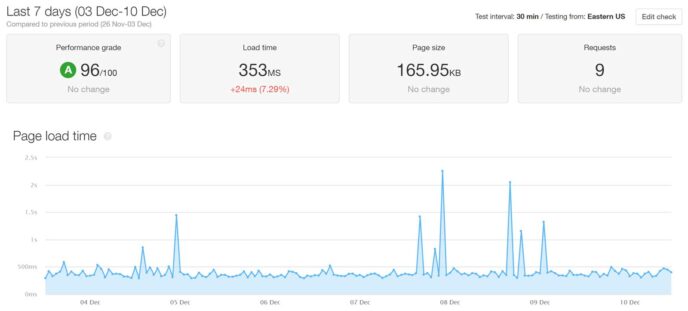
Pingdom recorded an average load time of 353 milliseconds for the site using the Twenty Twenty theme hosted by DreamHost.
SiteGround Lightweight Theme Speed Test Results
For the same site, but this time hosted on the SiteGround StartUp plan, Pingdom recorded a faster average load time of 289 milliseconds.
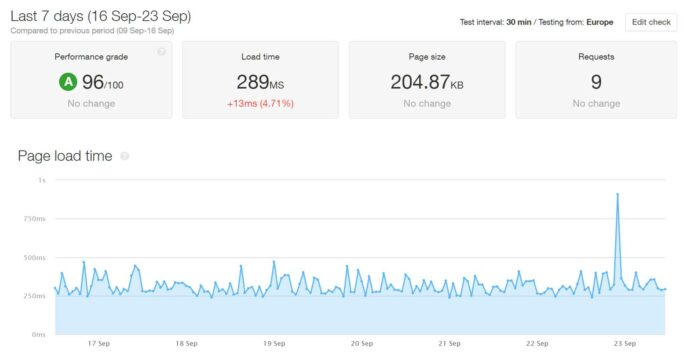
Pingdom recorded an average load time of 289 milliseconds for the site using the Twenty Twenty theme hosted by SiteGround.
Lightweight Theme Speed Test Results Summary
At the end of the testing period, Pingdom recorded a faster average load time of 289 milliseconds for the site hosted by SiteGround, compared to 353 milliseconds for the site hosted by DreamHost.
Both times were very impressive, especially if you consider that there’s not much difference between DreamHost and SiteGround and some of the more expensive premium managed WordPress hosts we’ve tested, including Kinsta (307 milliseconds) Liquid Web (358 milliseconds), and WP Engine (246 milliseconds).

The site using a lightweight theme hosted by SiteGround was 64 milliseconds faster than the DreamHost-hosted site.
While SiteGround was faster, with only 64 milliseconds between the sites, there wasn’t much separating the two hosts in this test. Let’s see if the difference is more pronounced for our test sites using a heavyweight theme…
Heavyweight Theme Speed Test Results
An alternative to using a lightweight theme like Twenty Twenty is to choose a more feature-rich multipurpose option. Doing so gets you access to lots of templates for your website as well as many extras, including page builder and slider tools.

The Avada theme has many prebuilt website demos including the feature-rich Agency demo.
Avada is one of the best-selling multipurpose WordPress themes, and due to the file size of the pages it generates, as well as its many features, it can be considered a heavyweight theme. Because of this, your website will be slower than it would be when using a lightweight theme.
So if you’re interested in using a theme like Avada and importing one of its demos, or building a similar type of site, let’s find out whether your website would load faster when hosted by DreamHost or SiteGround…
DreamHost Heavyweight Theme Speed Test Results
After the Avada theme was installed and its Agency demo imported, Pingdom recorded an average load time of 2.11 seconds for the homepage of the site hosted by DreamHost.
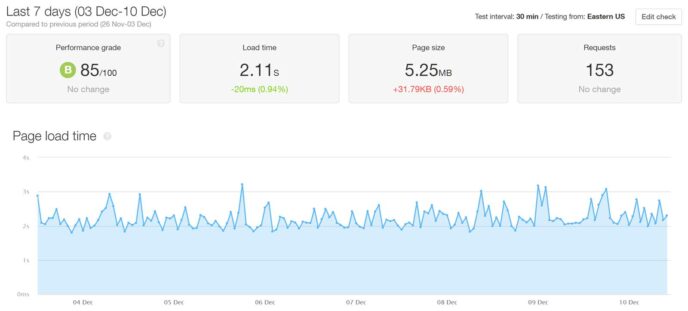
An average load time of 2.11 seconds was recorded by Pingdom for the site using the Avada theme hosted by DreamHost.
SiteGround Heavyweight Theme Speed Test Results
For the same site configuration, but hosted on the SiteGround entry-level StartUp plan, a faster average load time of 1.69 seconds was recorded by Pingdom.
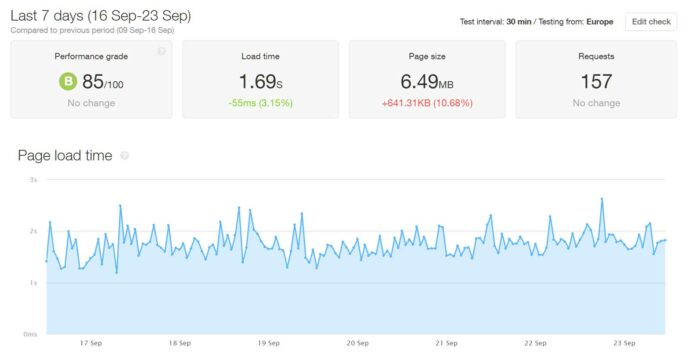
Pingdom recorded an average load time of 1.69 seconds for the SiteGround-hosted site using the Avada theme.
Heavyweight Theme Speed Test Results Summary
As you can see, the sites using the heavyweight Avada theme were slower than the sites using the lightweight theme. The page being monitored also had a much bigger file size.
Due to the more resource-intensive design of the sites, the difference in the performance of the two hosts was more noticeable. This time there was 0.42 second or 420 milliseconds separating them, instead of the 64 milliseconds from the first test when the sites were using the lightweight theme.

SiteGround were nearly half a second faster than DreamHost in the heavyweight theme load time test.
So while there might not be much difference between SiteGround and DreamHost if you plan to use a lightweight theme or create a simple website, if you want to use a theme like Avada and import one of its demos, or build a similar site, SiteGround would be the better option in terms of pure speed.
DreamHost vs SiteGround Load Time Summary
Although the sites hosted SiteGround were faster, both hosts performed really well in the Pingdom speed tests.
As you can see in our recent SiteGround vs Bluehost and GoDaddy vs Bluehost comparisons, DreamHost and SiteGround performed better than those other shared hosts we tested.

Both of the SiteGround-hosted test sites were faster than the ones hosted by DreamHost.
However, although both hosts did well, SiteGround were faster than DreamHost in our Pingdom site speed tests, regardless of the type of theme used. Still, it’s worth remembering that SiteGround charge more for their shared hosting plans than DreamHost.
DreamHost and SiteGround vs Managed WordPress Hosting
There wasn’t much difference between our sites using a lightweight theme hosted by SiteGround and DreamHost and the more expensive managed WordPress hosts we’ve tested. However, if you plan to build a more complex website, then you would experience faster loading times by upgrading to managed hosting.
In our managed WordPress hosting reviews, we recorded faster times when using a heavyweight theme with Kinsta (1.25 seconds), Pressable (958 milliseconds), the WordPress.com Business plan (1.06 seconds), and WP Engine (929 milliseconds).
So, while the shared hosting plans from DreamHost and SiteGround are ideal for simple, minimal websites, you should consider higher-performance managed WordPress hosting if you’re going to build a more advanced site.
Load Handling Tests
The average load time isn’t the only metric to consider when evaluating the performance of a web host. You also need to know how well a host can handle multiple simultaneous visitors accessing your site and what impact this will have on performance.
As our test sites don’t receive any traffic, I used the K6 load testing service to simulate multiple users visiting them at the same time, over a set period. K6 recorded the response time of the sites during the tests to see what impact these virtual users had on performance.
Load Time vs Response Time
Although response times are different from load times, if the response time increases during the K6 load tests, you can assume that the load time will be negatively affected as well.
For the K6 load handling tests, the WordPress websites with the lightweight and heavyweight themes were used.
Lightweight Theme Load Handling Test Results
For the load handling tests of the sites using a lightweight theme, K6 was set to increase the number of virtual users accessing them from zero to 100 over a five-minute period.
The site hosted by DreamHost was tested first. As you can see on the graph below, the response time (blue line) increased as the number of simultaneous virtual users (grey line) accessing the site grew.
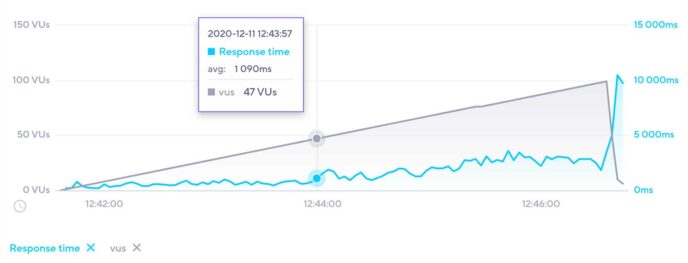
Once 47 simultaneous virtual users were accessing the site hosted by DreamHost, the response time had reached one second.
When there were 47 virtual users accessing the site hosted by DreamHost at the same time, the response time exceeded one second and continued to rise as the number of simultaneous virtual users increased.
When the SiteGround-hosted site using a lightweight theme was tested, the response time remained relatively stable during the five-minute period.
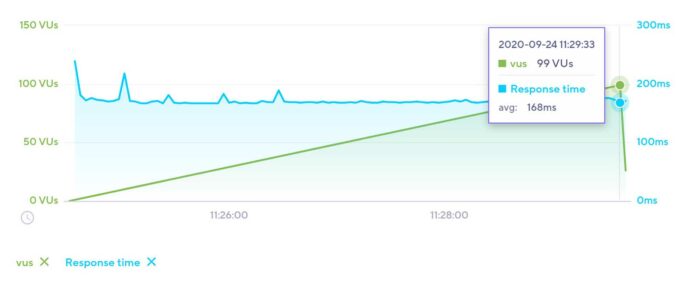
The response time of the SiteGround-hosted site wasn’t negatively affected during the load handling test.
Even when there were 100 simultaneous virtual users accessing the site, the response time remained below 200 milliseconds or 0.2 seconds.
Heavyweight Theme Load Handling Test Results
During the first test of the site using a heavyweight theme hosted by DreamHost, a maximum of 100 simultaneous virtual users was too much, and the response time hit a peak of 39 seconds. After reducing the maximum number of virtual users to 50 and rerunning the test, the results were more meaningful.
However, as the graph below shows, the response time (blue line) still reached two seconds by the time there were 18 virtual users accessing the site hosted by DreamHost at the same time.
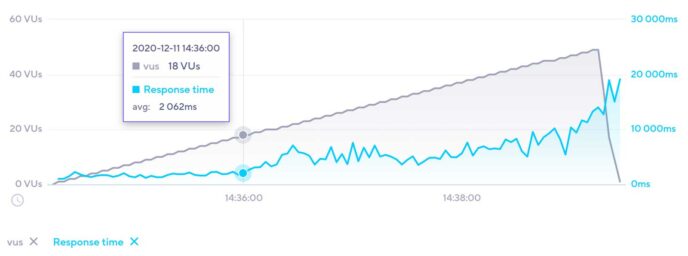
For the site hosted by DreamHost using the Avada theme, the response time (blue line) reached 14 seconds by the end of the test.
The SiteGround-hosted website did much better and was able to handle up to 100 simultaneous virtual users without the response time increasing much, even though the heavyweight Avada theme and its Agency demo were being used.
Even with 99 virtual users accessing the site at the same time, the response time (blue line) was only 326 milliseconds.
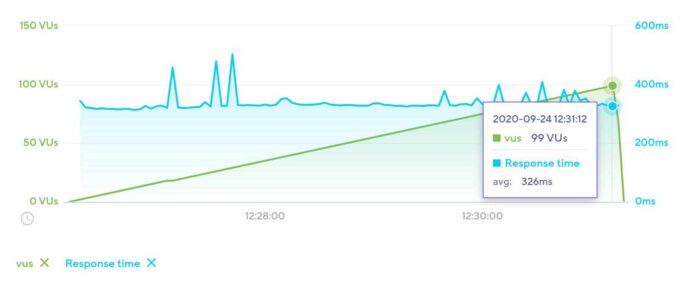
The response time (blue line) of the SiteGround-hosted site using the heavyweight theme remained stable as up to 100 virtual users accessed it.
Load Handling Test Results Summary
The response times of the sites hosted by SiteGround were largely unaffected as the number of simultaneous virtual users increased to 100. In fact, if you check out our SiteGround review, you’ll see that our sites were able to handle up to 200 virtual users without any problems in similar tests.
These results suggest that your website should be able to handle up to 200 multiple visitors accessing it at the same time without much, if any, reduction in load times. However, that does depend on the type of site you build and what your visitors are doing during their visit.
The fact that SiteGround have now incorporated the Google Cloud platform into their hosting infrastructure could explain why they can handle so many simultaneous visitors.
The sites hosted by DreamHost did experience an increase in response times in both tests. While the site using the heavyweight theme really struggled, the site using the lightweight theme performed much better.
However, unlike the SiteGround-hosted sites, even the site hosted by DreamHost using the lightweight theme experienced an increase in response times as the number of virtual users accessing it increased. Based on this, you should expect your site to slow down when it gets busy if you host it with DreamHost.
SiteGround vs DreamHost Uptime Monitoring
Finally, the four test sites hosted by DreamHost and SiteGround were monitored by Pingdom to see if they experienced any downtime.
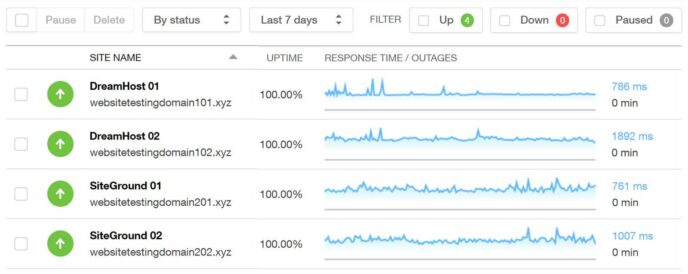
Pingdom didn’t detect any downtime for the four test sites hosted by DreamHost and SiteGround.
As you can see from the image above, during the seven days of monitoring, no downtime was recorded for either host.
DreamHost vs SiteGround Technical Details Overview
In case you want to know more about the shared hosting plans from DreamHost and SiteGround, here’s an overview of their main details:
- Website caching: The DreamHost and SiteGround shared plans use the OPcache engine for caching websites that use PHP, including WordPress websites. The SiteGround shared plans also use Memcached to improve website performance. DreamHost recommend the popular WP Super Cache plugin, while SiteGround has its own SG Optimizer WordPress plugin that lets you cache and optimize your site in many different ways.
- Content Delivery Network (CDN): Both hosts make it easy to integrate your account with the free and paid Cloudflare plans as well as with other CDNs.
- PHP: DreamHost let you choose from PHP versions 7.2, 7.3, and 7.4, while with SiteGround you can choose between versions 7.0 and 7.4, as well as version 5.4.
- HTTP/2.0: HTTP/2.0 is automatically enabled on the DreamHost and SiteGround shared plans.
- SSL: Both hosts provide you with a free SSL certificate from Let’s Encrypt. You can also import your own certificate or purchase a different certificate through both DreamHost and SiteGround.
- SFTP: You can create multiple Secure FTP accounts to access your web space for uploading and editing files with both DreamHost and SiteGround.
- Server file manager: You can access your server space via a browser-based file manager accessed with both hosts.
- Database access: Both DreamHost and SiteGround give you the ability to access the WordPress database via phpMyAdmin through a browser.
- Email service: All of the shared SiteGround hosting plans and the top DreamHost Shared Ultimate plan include an email service that features web mail, POP3, and SMTP. You can add email to the entry-level DreamHost Shared Starter plan for a small monthly fee.
- WordPress website management: There are optional automatic WordPress software and plugin updates with DreamHost and mandatory WordPress software updates and optional plugin updates with SiteGround.
- Plugin restrictions: As neither host has a list of disallowed plugins, you can install any extensions that you want.
- Security measures: DreamHost have DreamShield and SiteGround have SG Site Scanner paid add-ons, that include daily malware scans, automatic malware removal, and more security features. ModSecurity is installed on all SiteGround shared services and can be enabled with DreamHost.
- Post-hack clean-up services: DreamHost have a paid Hacked Site Repair service. SiteGround don’t have a dedicated clean-up service, but recommend Sucuri. Both the DreamShield and SG Site Scanner add-ons can help with this, too.
- Data center locations: With DreamHost, you can choose between two US data centers in Virginia and Oregon. SiteGround have six data centers on three continents and use the Google Cloud platform as part of their infrastructure.
- Staging sites: The SiteGround shared plans include access to a website staging tool, but the DreamHost shared plans do not.
- WordPress website migration: Both hosts will migrate a website to their service for a fee and also have free migration plugins that you can use to do it yourself.
- Uptime checks and guarantee: Both hosts monitor their servers for downtime but not individual customer websites. DreamHost guarantee 100% uptime while SiteGround guarantee 99.9%. Both hosts will provide compensation when downtime occurs.
- Support channels: DreamHost provide 24/7 support via live chat and a telephone call back service, while SiteGround provide support 24/7 via live chat, email ticketing, and telephone.
You can view the full details of the shared plans from both hosts on the DreamHost and SiteGround websites.
Final Thoughts
Based on our performance tests, DreamHost have one of the best site-speed to value-for-money ratios of any shared host we’ve tested so far.
If you plan to use a lightweight theme or build a simple website, you could enjoy fast loading times while also paying some of the lowest hosting fees around. Even if you use a heavyweight theme or build a more complicated website, your site should still load reasonably fast with DreamHost.
That being said, SiteGround did perform better than DreamHost in our load time and load handling tests.
However, the SiteGround shared plans are more expensive than those from DreamHost. Your money does get you better performance as well as some extra features, such as an in-house caching and optimization WordPress plugin, a website staging tool, and email ticket support. Thanks to SiteGround now using the Google Cloud platform for part of their infrastructure, you get more data center locations to choose from as well.
If you’re not put off by the price of the SiteGround shared plans, you will get more for your money, both in terms of features and performance. But if you’d rather pay less, DreamHost are a great compromise, and it’s unlikely you’ll be disappointed. Their 100% uptime guarantee and 97-day money-back refund policy inspire confidence, too.
Used/using either of these two hosts? Thoughts?
Joe is an experienced WordPress user who enjoys sharing the tips and knowledge he’s picked up from using this fantastic platform for many years. You can find out more about Joe on his website.
Keep reading the article at WinningWP. The article was originally written by Joe Fylan on 2021-01-10 09:26:32.
The article was hand-picked and curated for you by the Editorial Team of WP Archives.

